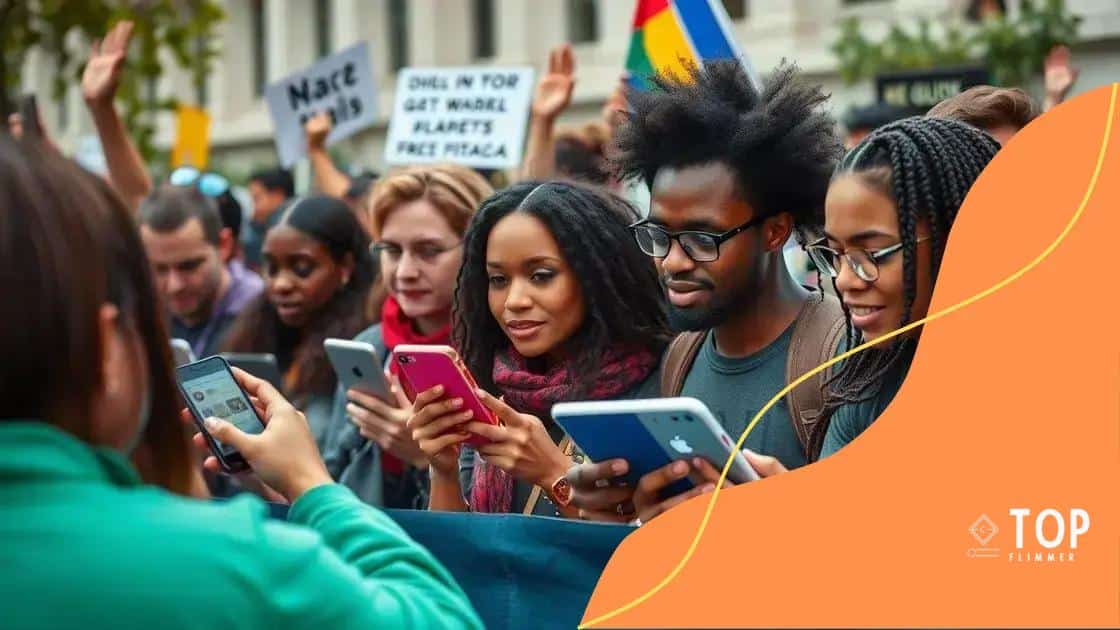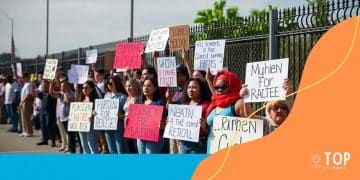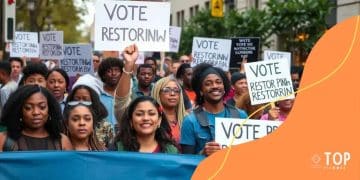Protest movements for police accountability reforms

Protest movements for police accountability reforms aim to enhance transparency and justice in law enforcement by advocating for significant legislative changes and utilizing social media to mobilize communities and raise awareness.
Protest movements for police accountability reforms have gained momentum in recent years, reflecting a growing demand for justice and transparency. Have you ever wondered how these movements shape public policy and community resilience? Let’s explore their impact.
Understanding the historical context of police accountability
Understanding the historical context of police accountability is crucial for grasping how current movements have emerged. Over the past century, various events have fueled the demand for reforms, marking significant turning points in society.
Throughout history, communities across the nation have rallied against instances of police misconduct. For example, the civil rights movement in the 1960s highlighted the urgent need for accountability in law enforcement. Incidents of brutality and bias sparked protests that paved the way for legislation aimed at reforming police practices.
The Role of Key Events
Key events often serve as catalysts for reform. Some notable incidents include:
- The Los Angeles Police Department’s response to the Rodney King beating in 1991.
- The killing of Michael Brown in Ferguson, Missouri, which ignited widespread anger and protests.
- The death of George Floyd in 2020, which led to a global movement advocating for justice and accountability.
These events have not only highlighted police misconduct but also served to unify communities in their quest for justice. The impact of such tragedies has led to the formation of grassroots organizations dedicated to holding law enforcement accountable.
Moreover, the role of public perception cannot be understated. As social media rises, the dissemination of information regarding police actions has increased. This visibility has played an essential part in galvanizing support for change, as communities engage with and respond to injustices.
Consequently, understanding these historical contexts remains vital. The struggles, successes, and ongoing efforts shape the discourse surrounding police accountability reforms. By recognizing how past events inform today’s actions, we can better understand the momentum behind contemporary movements.
Key figures and organizations in the protest movements
Key figures and organizations have played a significant role in shaping protest movements around police accountability reforms. Their leadership and activism are essential in driving change and rallying communities.
Prominent activists have emerged as voices for the voiceless, utilizing their platforms to bring attention to issues of systemic injustice. For example, individuals like Al Sharpton and Patrisse Cullors have raised awareness about police brutality and organized countless rallies advocating for justice.
Influential Organizations
Various organizations have also made an impact on the movement. Some key players include:
- Black Lives Matter: Founded in 2013, this movement has mobilized protests worldwide following high-profile incidents of police violence.
- The American Civil Liberties Union (ACLU): This organization works on various issues, including police accountability, to protect civil rights and liberties.
- Color of Change: This online racial justice organization focuses on promoting policies that address racial injustice, including demands for police reform.
These key figures and organizations inspire many to take action. Their efforts shine a light on the need for change in policing practices. Additionally, they foster community connections, helping people feel empowered to stand up for their rights.
The importance of collaboration among activists and organizations cannot be overstated. By uniting, they create a stronger voice, effectively advocating for reforms that can lead to a more accountable and just policing system.
Impact of social media on activism for reform

The impact of social media on activism for reform has transformed how movements operate today. In recent years, platforms like Twitter, Facebook, and Instagram have become essential tools for spreading awareness and rallying support.
Activists can share real-time updates and create hashtags that draw attention to critical issues. The viral nature of social media allows for information to spread rapidly, reaching audiences far and wide. For instance, the hashtag #BlackLivesMatter became a rallying cry, uniting people globally in the fight against police brutality.
Connecting Communities
Social media connects activists with communities, fostering engagement and dialogue. Through platforms, people can:
- Share personal stories that highlight experiences with police misconduct.
- Organize local protests and events efficiently.
- Collaborate with other advocacy groups to amplify their message.
Moreover, individuals who may have felt isolated can find a sense of belonging online. This network of support strengthens movements and encourages participation in activism. By sharing resources and strategies, activists leverage each other’s strengths to push for reform.
Importantly, social media also allows activists to hold police accountable by recording interactions and sharing footage. This transparency plays a crucial role in increasing public awareness of police actions and misconduct. By bringing these incidents to light, activists can push for legal changes and community oversight.
As movements grow, so does the need for critical engagement. While social media can mobilize large crowds, it’s essential to maintain focused, informed discussions. Activists must educate their online audiences about reform goals and the importance of sustained community involvement in the fight for justice.
Legislative changes stemming from protests
Legislative changes stemming from protests have reshaped the landscape of police accountability. In recent years, many movements have successfully pushed for new laws and reforms that address systemic issues within law enforcement.
One significant outcome of protests is the introduction of new legislation aimed at increasing transparency. For instance, measures like body cameras for police officers have been implemented in various jurisdictions. These cameras help document interactions with the public, aiming to reduce incidents of misconduct and establish accountability.
Key Legislative Changes
Several important legislative changes have emerged from recent protests:
- Ban on chokeholds: Many states have introduced laws prohibiting the use of chokeholds by law enforcement, emphasizing de-escalation strategies.
- Enhanced oversight boards: Some cities have set up independent oversight committees to investigate complaints against police officers, promoting accountability.
- Funding for community programs: Legislative efforts have redirected funding from police departments to social programs that address root causes of crime, such as mental health services and education.
These changes reflect growing public support for accountability in policing. As protests gained momentum, lawmakers faced pressure to respond to the demands of their constituents. This shift has made it clear that communities want changes within their police departments to build trust and safety.
Furthermore, grassroots efforts have amplified calls for specific reforms. Activists have successfully lobbied for bills that prioritize community safety and emphasize the need for officer training in areas such as mental health and conflict resolution. As a result, more comprehensive policies are being developed that aim to create long-term change.
As communities continue to advocate for reform, the push for legislative changes persists. Awareness of issues related to police accountability remains high, ensuring that lawmakers are held accountable to their constituents’ demands for justice and transparency.
Future outlook for police accountability movements
The future outlook for police accountability movements appears dynamic and promising. As communities across the nation continue to advocate for reform, the momentum behind these efforts shows no signs of waning. Growing awareness of issues related to police practices is likely to drive ongoing action.
One significant factor contributing to this momentum is the increasing participation of younger generations. Activists from diverse backgrounds are joining the fight for accountability, bringing fresh ideas and strategies. Their engagement through social media and other platforms amplifies their voices, making it easier to organize and mobilize.
Emerging Trends
Several trends are shaping the future of these movements:
- Focus on legislative reform: Continued advocacy for stronger laws aimed at increasing police accountability is expected. Many activists are pushing for comprehensive changes that address systemic issues.
- Community partnerships: Movements are increasingly building alliances with local organizations and community leaders. This collaboration strengthens efforts to promote justice and create safer neighborhoods.
- Enhanced training and education: Advocacy efforts are likely to emphasize the importance of training for law enforcement, covering topics like de-escalation and anti-bias strategies.
Moreover, as public support for accountability grows, policymakers may feel more pressured to act. The dialogues surrounding police practices are evolving, leading to broader discussions about social justice, equity, and systemic racism. This shift in conversation can lead to significant changes in public policy.
Additionally, the rise of technology plays a vital role in the future of these movements. Tools like body cameras and data transparency initiatives can help hold officers accountable, providing a clearer picture of police interactions. Coupled with grassroots activism, these advancements strengthen demands for accountability.
As movements adapt to new challenges and opportunities, the vision for police accountability reforms continues to expand. By staying connected and informed, activists can ensure that their efforts make a lasting impact.
FAQ – Questions about police accountability movements
What are police accountability movements?
Police accountability movements aim to promote transparency and justice in law enforcement, advocating for reforms to prevent misconduct.
How has social media affected these movements?
Social media has amplified voices, allowing for rapid spread of information and mobilization of protestors, making activism more accessible.
What are some recent legislative changes related to police accountability?
Recent changes include bans on chokeholds, funding for community programs, and enhanced oversight boards to investigate police actions.
How can I get involved in police accountability advocacy?
You can participate by joining local groups, attending events, and advocating for policy changes at community meetings.






